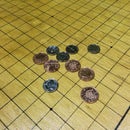Introduction: Acrylic Pour Painting - on a Budget
Is your drawing deplorable? Is your painting pathetic?
Well, acrylic pour painting is just the thing for you!
It needs no drawing or painting abilities and lets you act like a five-year-old by getting paint all over your hands. Yaayyy!
This Instructible will focus on acrylic pour painting, but on a budget. Most of the things can be bought from dollar/pound shops.
Here's what you'll need:
- PVA glue
- Water
Those will make up your pouring medium. You can get 500ml bottles of glue from dollar/pound shops.
- Acrylic paint
You can get these cheap from dollar/pound shops, but I'd recommend getting some decent student/artist quality stuff from Amazon. Acrylic paint is pretty cheap. Get big tubes of the stuff as you'll use lots of it. For white, get a big 500ml tub as it's the most commonly used colour.
- Something to pour paint over
- Gesso (optional)
You can buy cheap box canvases (a wooden square/rectangle with canvas stretched over it) or you can use bits of wood. If you use wood you'll need to get Gesso. It's like undercoat, but a bit rougher. Hell, try cheap undercoat, it might work. Box canvases come pre-primed with Gesso.
- plastic cups (various sizes)
- lollipop sticks
- latex gloves (optional)
- plastic sheet (for minimising mess - optional)
You'll mix paint in the plastic cups, and stir it with the lollipop sticks. Buy different sizes of cups such as 7 or 8oz and even some little shot cups. You'll need over half of an 8oz cup to cover about an A4 sized canvas. Gloves are for sissies. Get your hands dirty dammit!
- treadmill silicone
Silicone is the secret ingredient that makes the paint go all funky. You only need about 3 drops of this in some cups to give that cell look to paintings. You need to get 100% silicone. Some cheap dollar/pound shops do 3-in-1 or WD40, but most aren't 100% silicone. You'll probably need to get this from Amazon/eBay.
- butane blow torch
These are the butane-filled ones that are used in kitchens. You can get them on Amazon for about £10-15. You'll need this to activate the silicone and pop bubbles. If cells aren't your thing then you don't need this.
Step 1: Step 1 : Pouring Medium
So, we need to make a pouring medium that we add to the paint to make it more runny. Here's what I do...
Take the squeezy bottle of PVA glue and take 1/3rd out of the bottle. Obviously, keep that as you can still use it. Now, top the squeezy bottle up to its original level with water.
Give it a good shake to get the glue and water mixed.
Done!
That's now your pouring medium.
Water down that 1/3rd that you took out at the start and use that too.
Remember: whatever you have in glue, add half of that in water to get pouring medium.
Step 2: Step 2 : Mixing Paint
Now we need to get the paint ready to put on the canvas.
Take a cup and add a single colour of paint to it. Let's say it's a nice blue colour. Not too much paint (maybe 5mm deep) as we'll be adding about the same in pouring medium.
Squish some pouring medium into the cup (which has the paint) and stir with a lollipop stick.
You want to get the paint to the same consistency as warm honey. When you scoop some paint onto the lollipop stick and let it run off it should run off in a continuous thread, but not like water. That's too runny.
So, do that for each colour you want to use. Choose the three primary colours (red, blue, and yellow) and some white. You'll now have four cups. Each with some runny paint.
TIP: try and use more colours and less white. I find that white makes the painting go all pale and dull looking.
Looking at the four cups. Do you think if you poured them all into one cup you'll have enough to over half-fill it? If so, good. If not, mix more paint.
Lastly, add the magic sauce: about three drops of silicone to some of the cups. Which cups? That's up to you. There's no exact science to this. Try adding it to the colours. Not the white. It's all trial and (lots of) error.
Step 3: Step 3 : You Dirty, Dirty, Cup
We'll do what's called 'a dirty cup' flip.
Put out four new cups upside down. This is to put your canvas/board on when the paint is running off it. Some people use push-pins to lift the canvas/board.
Take a new cup and start pouring in some of the paint. Try a bit of white. Some red (just a little), some blue, some yellow. Maybe a bit more red? Some more white? Sure, why not. Keep pouring them into the cup until you've got over half of an 8oz cup.
Take a lollipop stick, put it in the cup, and draw a number 8. That's it. Nothing more. It's just to get the colours moved about in the cup.
Take your canvas/board and put it upside down over the cup.
Hold the cup and the back of the canvas/board and flip the whole thing upside down. Put it on your four upturned cups. These act as legs and let any paint drip and run off the sides.
Wait a few seconds for the paint to run down inside the cup. Maybe give it a few gentle taps on the butt to help it?
TIP: you can spray some WD40 inside the cup (and spread it around) before adding the paint. This will stop the paint sticking to the cup and get all that painty goodness out.
Step 4: Step 4 : the Big Reveal! Kinda...
OK... here's where the fun starts. You want to lift the cup at a bit of an angle as you effectively want to break any seal that might happen between the cup and the canvas/board.
Whoom! The paint will form a big circle in the middle of the canvas/board.
Get your heat source and quickly run it over the paint to pop any bubbles and get the silicone doing its magic.
We need to help the paint here by tilting the canvas/board to spread the paint.
Golden rule: don't keep moving the paint about as you'll start mixing it and getting dirty colours.
Tilt the canvas/board to one corner letting a little bit of paint run off the sides. Use your finger to scoop up some of the dripped paint and dab it on the corners and along the sides. Let the paint run back to the centre of the canvas/board before tilting to another corner and repeating the scoop and dab thing.
You don't want to let too much run off the canvas/board or you won't have enough left to reach all four corners.
TIP: if you do run out of paint, and you have a bare corner of canvas/board, just scoop some out of what's left on the cup and slap that in the empty space. Get creative.
So, you've covered the canvas/board. Put it back on the cups and give it a final torching.
Step 5: Step 5 : the Final Reveal
So, you're done. But wait! There's more!
Let the canvas/board sit for a few minutes. It still has things going on in there. Over a short space of time, you'll see some paint colours will rise, some will fall. More cells will appear, some will get bigger.
It's chaos in action!
All of these things depend on the type/colour of paint used. The amount of silicone used. Which colours you did/didn't put it in etc etc.
Step 6: Step 6 : There's More!
The dirty flip cup is just one of many things you can do to put paint on the canvas/board. Here are a few more:
- Dirty pour: you make a dirty cup as before put pour it onto the canvas/board
- Rings: gently wobble a pouring cup (see above) in one spot to create rings. You'll need some paint left in the cup to cover the corners. You don't want to move the canvas/board too much otherwise you can lose the ring effect.
- Slide: cover the entire canvas/board in paint (with pouring medium of course) then do a dirty flip cup (but without flipping the canvas - here you need to flip the cup only! Nerves of steel!). Don't lift the cup this time. Here you slide it over the canvas/board.
- Open dirty cup: Place a cup upside down (bottom cut out) on the canvas/board and put paint in it like a dirty cup. You can drag or lift the open cup.
- Several dirty/flip cups: get creative and use 3 or 4 shot cups with different colours in each and put them on the canvas
- Swipe: use a dirty cup, or a dirty pour to get paint on the canvas then use a spatula or paper towel to swipe the paint across the canvas/board
Be adventurous with it. Try different cups or things to get some weird and wacky effects. Pour through a sink strainer? Sure, why not. Collander? Yeah.
Step 7: Step 7 : Ooh! Shiny!
Once your canvas/board has been sitting for a few days and is completely dry you should put a couple of coats of varnish on it to protect it, and to pop those colours.
Varnishing is optional as acrylic paints are waterproof once dry.
Step 8: Step 8 : Disclaimer
Remember: this is acrylic pour painting on a budget.
Possibly the paints, and or the PVA glue, will not be archival. By that I mean the colours may fade/tint over time.
Artists quality paints will not discolour over time, but they are more expensive.
The PVA glue may tint over time. The only way around that is to get proper bookbinders glue, but (again) it's expensive stuff.
So how long will it take for it to fade/tint? No idea. More importantly: who says they definitely will fade/tint? Not me!
Just enjoy getting messy. Give some as gifts. Hang some in your home to make it all funky looking.
Enjoy!













